The peacoat, sometimes spelled pea coat, is an icon in the world of classic overcoats, known for its durability and ability to provide extra warmth for its wearer even out on the blustery high seas. Favored by sailors from across the globe, including the British Royal Navy and the US Navy, it is a singular example of a military garment that has influenced Classic menswear.
We will explore the history of this classic garment and detail how to find the right cut, fabric, and buttons so you can make an informed decision about your own peacoat purchase.
We will also consider the role of the peacoat in contemporary menswear, including tips on how you can incorporate this classic menswear item into your outfits.
The History of the Peacoat
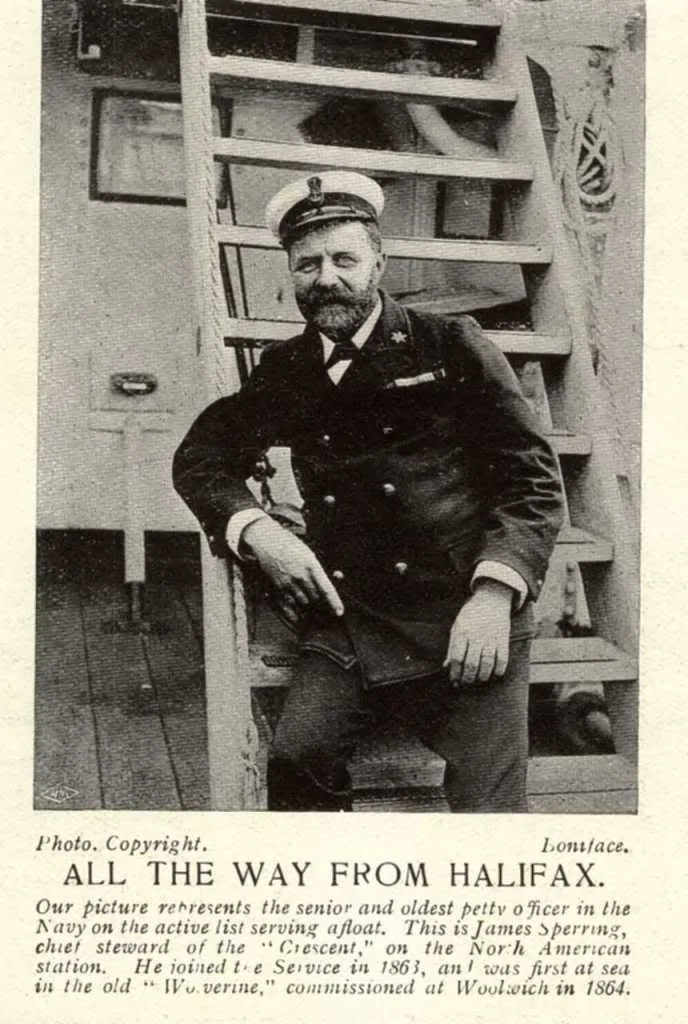
Unlike the more defined history of the Trench Coat, the origins of the peacoat are more ambiguous. A version of the jacket has been worn by European and American sailors for nearly three centuries, so it’s probably not surprising that there are several different versions of the peacoat story out there. Let’s look at them one by one. Like many garments, the history of the peacoat may not be exact, but it has certainly left an indelible impression on classic fashion.
Three Origin Stories for the Peacoat
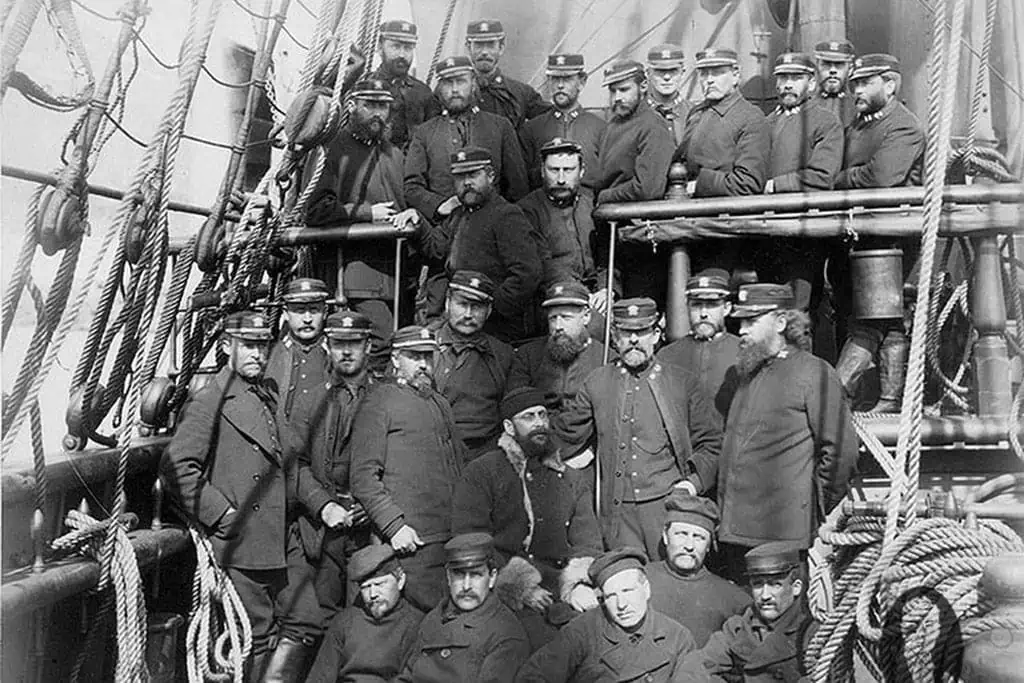
Peacoat Origins: The Dutch Version
The Oxford Dictionary dates the origin of the term pea jacket or peacoat to the early 18th century, claiming that it was most likely derived from the Dutch word pijjakker, from “pij” for ‘coat of coarse cloth’ + jekker for ‘jacket’. Since the Dutch were a naval power for many centuries, and the peacoat is commonly associated with seafaring, it does not seem far-fetched that the jacket was in fact from the Netherlands.
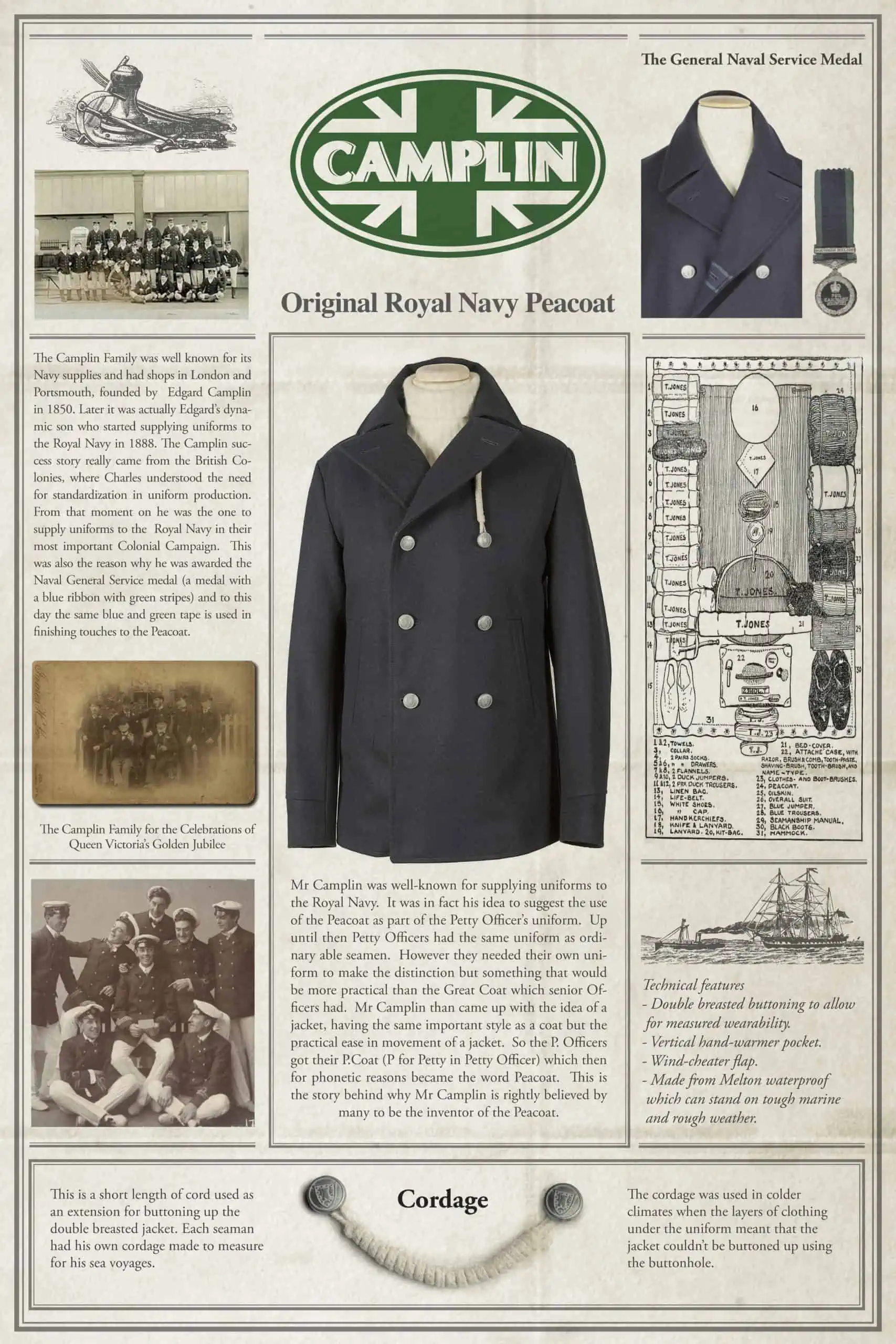
Peacoat Origins: The Camplin Version
According to Camplin, a heritage British clothing brand that is now based in Italy, Mr. Edgard Camplin founded a store in 1850 in which he sold uniforms to the British Royal Navy. Apparently, the article sold particularly well in India, starting in 1888. After that, Mr. Camplin supposedly suggested – at an unknown date – creating a coat for the uniform of petty officers, who had the same uniform as sailors up until then.
Instead of the officer’s greatcoat, Camplin designed the Petty Coat, which was also known as a P. Coat. The name eventually was popularized as Peacoat for phonetic reasons. This version of the story may be true, but it does not name any sources or dates other than the company’s own records; the company still sells peacoats based on the story that Mr. Edgard Camplin “invented” the peacoat.
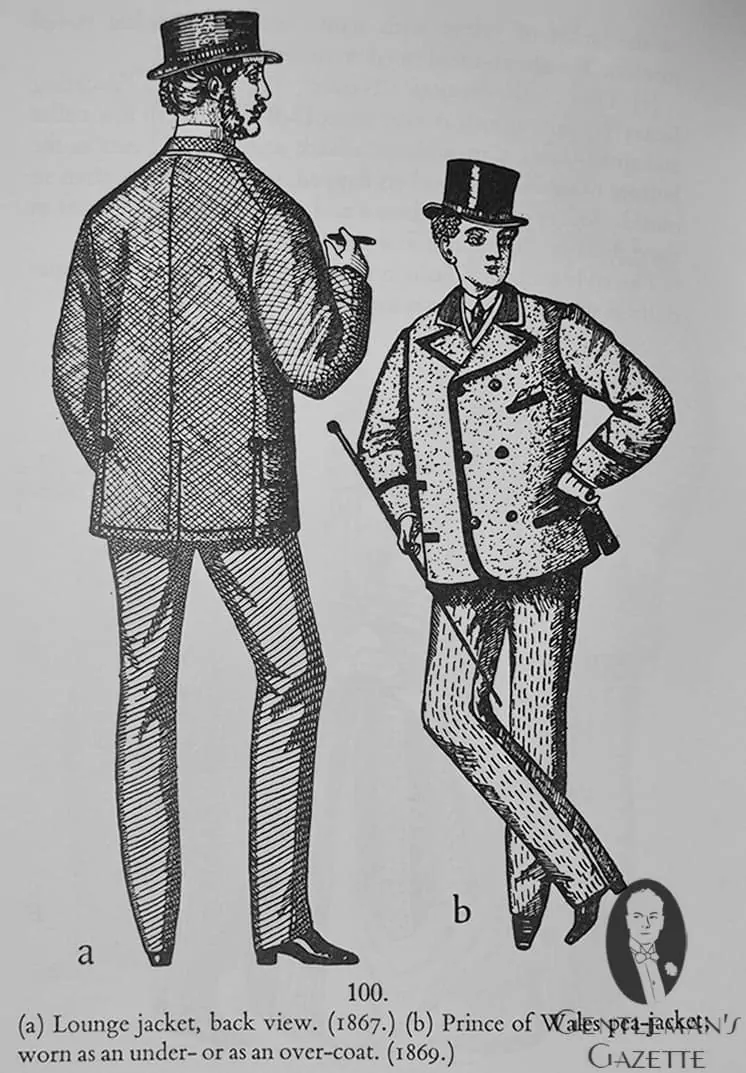
Peacoat Origins: The Tailor & Cutter Version
The Tailor & Cutter used to be the leading tailor trade magazine in England in the 19th century. It was published weekly and in addition to focusing on tailoring and cutting, it also featured fashion trends and etiquette. For example, if people began wearing new styles, Tailor & Cutter would comment on the clothing, which was particularly true for anything a Royal wore. In an issue from October 1868, they report about the so-called “the Prince of Wales Jacket” emerged, which characterized it as a loose double-breasted jacket with three pairs of buttons, two cross pockets, and wide piping.
When intended for rough use, the coat was made of blue pilot cloth lined with wool. For town wear, it was made of blue witney or another soft material with silk-faced lapels and a velvet collar. It was tailored with or without a back seam and with short vents at the bottom. The illustration is from 1869 and describes it as a “Prince of Wales pea-jacket”. Chances are, the PoW was not the inventor, but rather he was the person who popularized it.
Peacoats Become Iconic During the World Wars
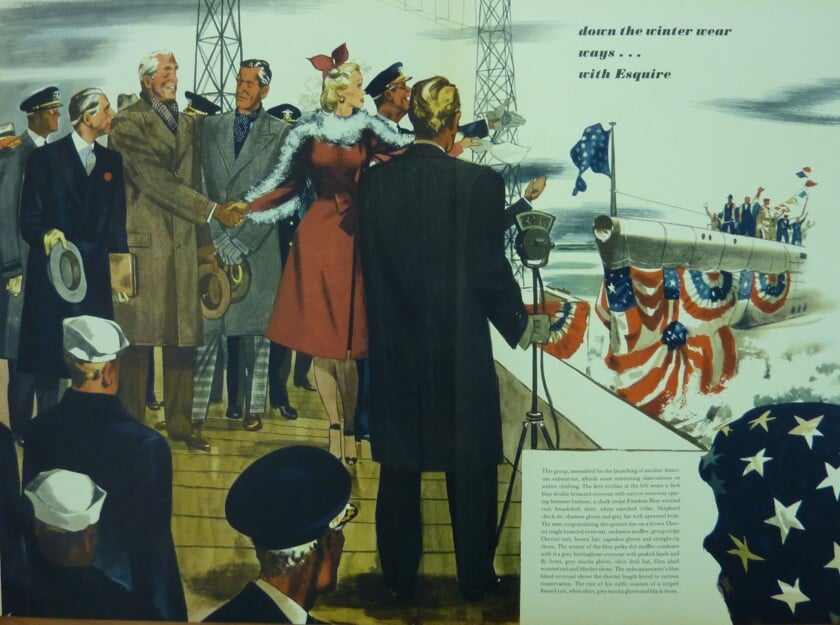
During both of the World Wars, peacoats became an iconic emblem of the seamen of the United States Navy. Many navies, however, adopted the peacoat, and it was sometimes even worn by forces fighting on the land. Durable and insulating, the peacoat was an essential article for sailors in peace and wartime.
Inspired by the fighting spirit of these sailors, the peacoat became an increasingly popular postwar garment for civilians, especially after World War II. In this regard, the peacoat is similar to the trench coat, which enjoyed popularity after World War I, and the bomber jacket, which proliferated, like the peacoat, after World War II.
Learn how the military inspired Classic Menswear!
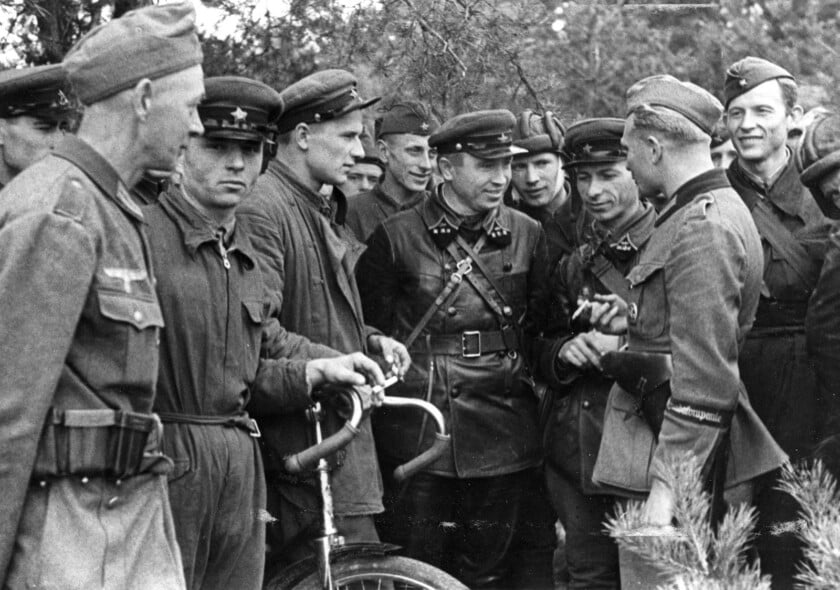
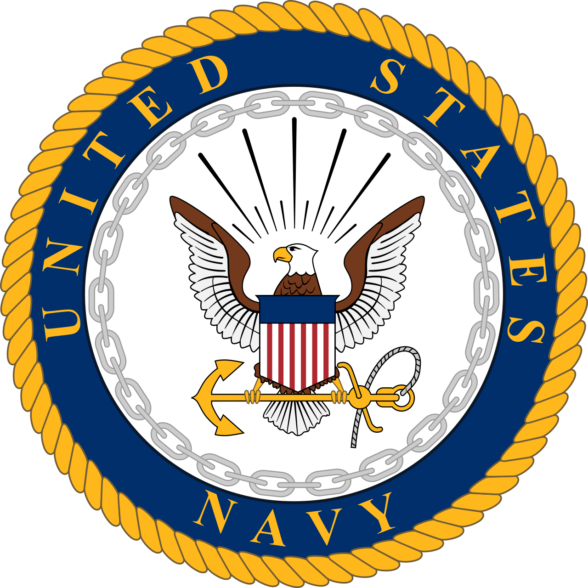
Why the US Navy Peacoat is
Discontinued
In 2018, United States Navy high command decided to replace the traditional peacoat with a synthetic-material black parka. This decision was made to update the image of the modern American sailor and from a “desire to reduce current Navy sea bag uniform component requirements and reduce cost to the Navy’s annual uniform budget,” according to USNI News.
The Peacoat as Fashion Icon
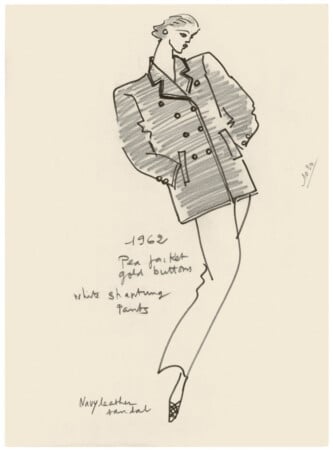
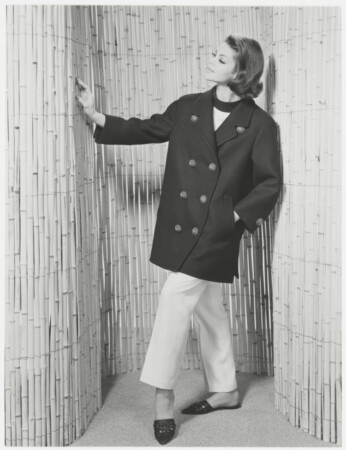
Throughout the second half of the 20th century, the peacoat became increasingly common as a casual coat for civilians: hardwearing, masculine, and eminently insulating, the peacoat had romantic flair and a rakish charm that made it extremely popular. Eventually, even ladies began to wear variations of the peacoat.
Peacoat FAQs
Why is it called a peacoat?
There are several different versions of how the peacoat got its name. In one instance, it may come from the Dutch word pijjakker meaning “coat of course cloth”, another instance sees the peacoat derive its name from the brand Camplin who called it a “petty” coat, and a third possibility sees a coat of similar construction described in the Tailor & Cutter magazine as being a “pea-jacket”. Whichever is true, the name remains consistent!
How should a man wear a peacoat?
A peacoat is a great piece of outerwear for lovers of classic style, as it allows you to dress down (or up!) depending on the occasion. It can be smartened with flannel trousers and fine knitwear, or relaxed with corduroys and a chunky sweater. As a general rule of thumb, avoid wearing a peacoat with anything formal, such as a suit, as this will create a clash in formality.
Who made the first peacoat?
It’s difficult to say who made the first peacoat, as there are three possible origins to the garment. Whether it was at the hands of the Dutch or the English, the peacoat’s general design has remained largely unchanged. This means it won’t be hard to find an authentic peacoat that you like.
What is the difference between a peacoat and an overcoat?
Mainly, the length is the largest difference between a peacoat and an overcoat. A peacoat is designed to be much shorter than an overcoat, finishing around the seat. This is because of the naval heritage of the garment; a longer coat would be hazardous on treacherous sea voyages.
Are peacoats supposed to fit tight?
Historically, peacoats were cut to fit quite close, but certainly not tight. Therefore, you want there to be enough room under your peacoat for a thick sweater, but you shouldn’t have so much room that you’re drowning in it – peacoats are not designed to be worn oversized! Aim for that comfortable middle for the best fit.
Can you wear a peacoat unbuttoned?
The military dress code states that all buttons save for the collar button should be fastened on a peacoat, with the collar button being allowed in particularly bad weather. For civilians, however, there are no hard and fast rules about how to button a peacoat. Bear in mind that as it’s a double-breasted garment that’s designed to keep you warm, it can look a little odd to wear it unbuttoned, but it makes sense to do so if you’re feeling warm and don’t want to carry it.
How do I get my peacoat collar to stay up?
The collar on a peacoat should be created in the ulster style, meaning the collar points face down, rather than up as if they were on a suit jacket. This is essential in keeping you warm in inclement weather, as you can flip up the collar and allow the points to cross over in the front. If the collar doesn’t stay up by itself, it’s worth taking your peacoat to an alterations tailor so they can insert some stiffer interlining into the collar. This will help your peacoat collar to stand proud and keep you warm!
What is a Peacoat?
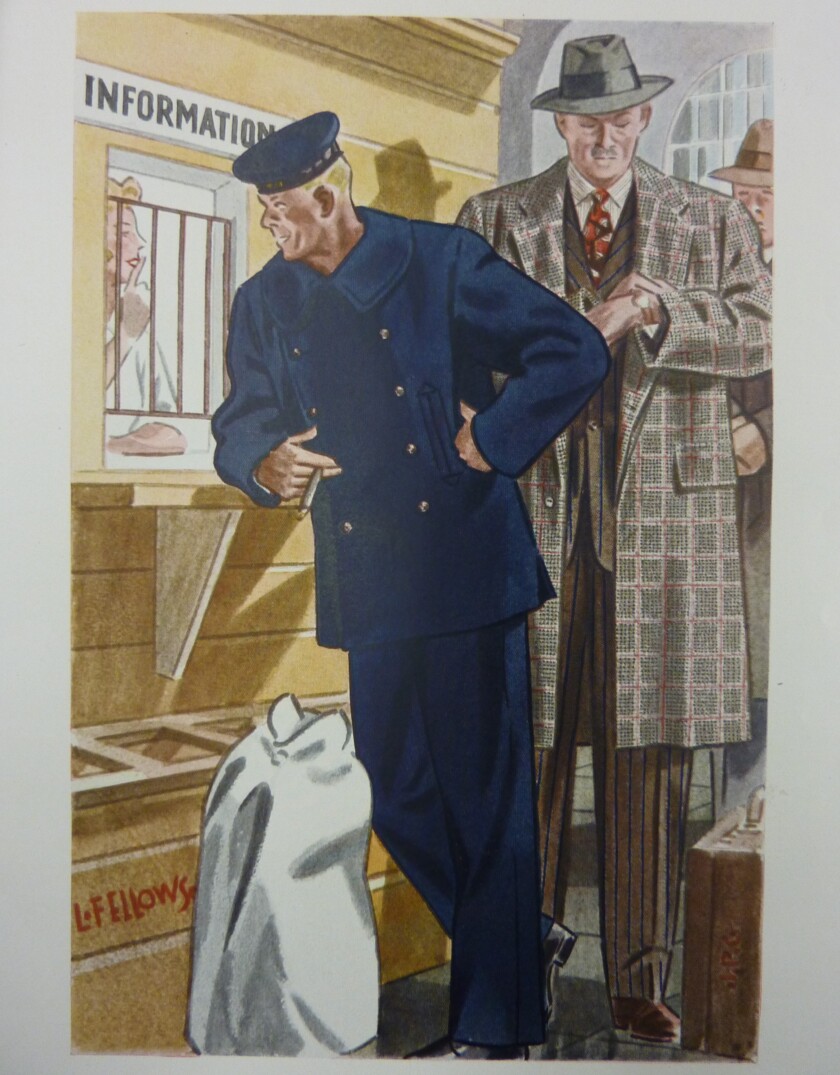
All these historical details now beg the question: what is a peacoat today? Let’s take a look at the three major components of a peacoat’s construction: the cut, the fabric, and the buttons.
The Correct Peacoat Style
As a peacoat differs from other types of wool coats, it’s important to understand what makes it so unique. While there are many other variations of men’s pea coats out there, we’ll be focusing on the naval peacoat in our breakdown. Sure, there are many designer peacoats out there, but we feel the military offers perhaps the best look at the most timeless peacoat design.
The Correct Peacoat Style
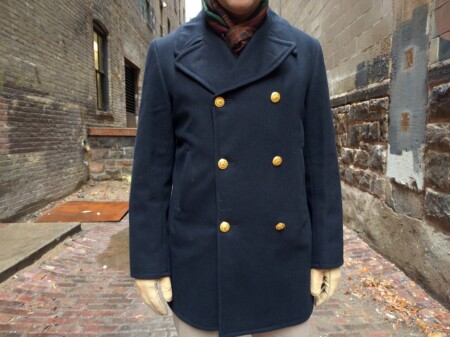
The Peacoat Cut
The peacoat of today has a specific cut that reflects it’s functional origins. The peacoat is a simple jacket with a straight cut down the body. The length is slightly longer than a regular jacket, but it remains shorter than an overcoat like its predecessor.
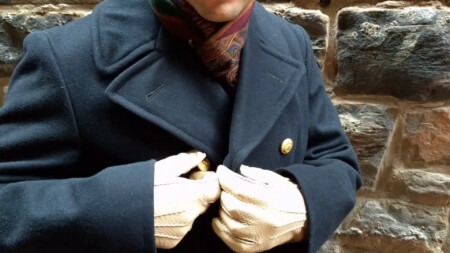
The Peacoat Collar & Buttons
An oversized wide collar, typical of an Ulster coat, allows the wearer to button up the collar around the face for extra protection from the elements, using the 7th button (and occasionally the cordage, depending on the brand). If seafarers wore many layers underneath, they were sometimes unable to button that 7th button and so they used cordage. The remaining 6 buttons are arranged traditionally on the double-breasted silhouette.
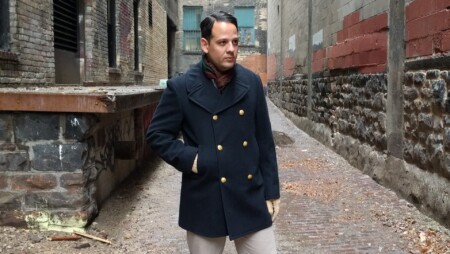
The Peacoat Details
The very first peacoats seem to have had short side vents or no vents, whereas current US Navy peacoats feature a centre vent. The vertical slit pockets were designed for easy access, and they usually also feature a little change pocket on the inside because US Navy pants did not have pockets. On the inside, you will find two pockets on either side for storage of your everyday carry items.
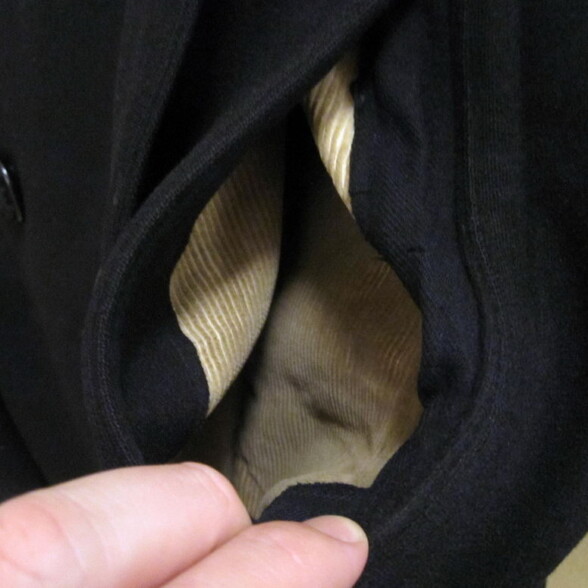
Most peacoats have
Deep Pockets
Both as a safe haven to protect the hands from the elements and as a location for the storage of extra items, most peacoats feature voluminous, welted pockets. The pronounced slant typical of these pockets ensures that whatever is placed inside of them will not fall out.
Aside from these simple details, the peacoat features no additional ornamentation, but it’s simplicity and clean lines have made it a reliable standard for a classic wardrobe.
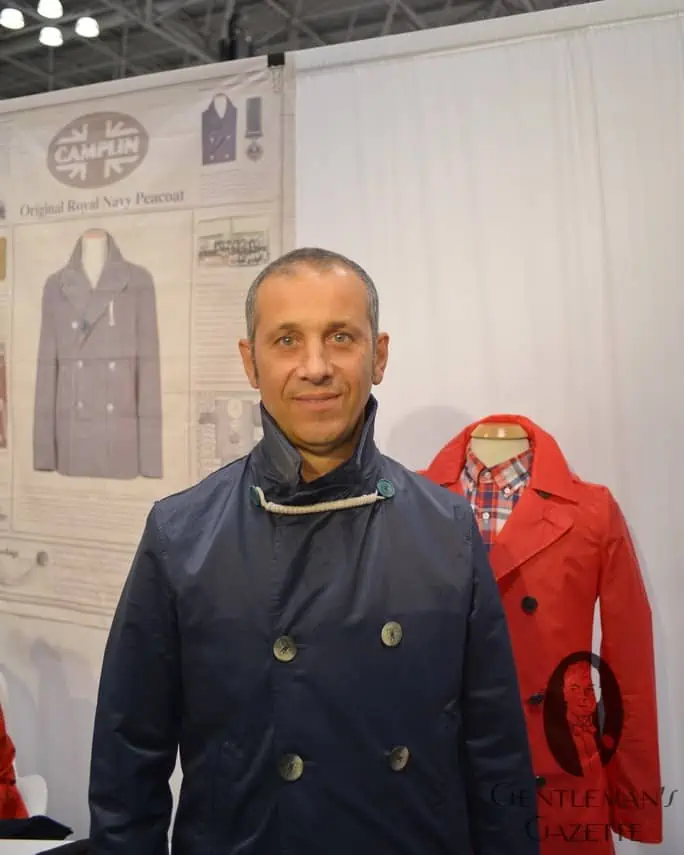
The peacoat is “a double-breasted, hip-length coat made of dark blue authorized fabric with a convertible collar, a set-in pocket in each forefront, and a single row of four 35-line plack plastic anchor buttons down the right front and three on the left…. Button all buttons except collar button. The collar button may be buttoned in inclement weather. Wear the jumper collar inside the coat. Sleeves are to reach about three-quarters of the distance from the wrist to the knuckles when arms hang naturally at the sides.”
US Navy guidelines regarding the peacoat
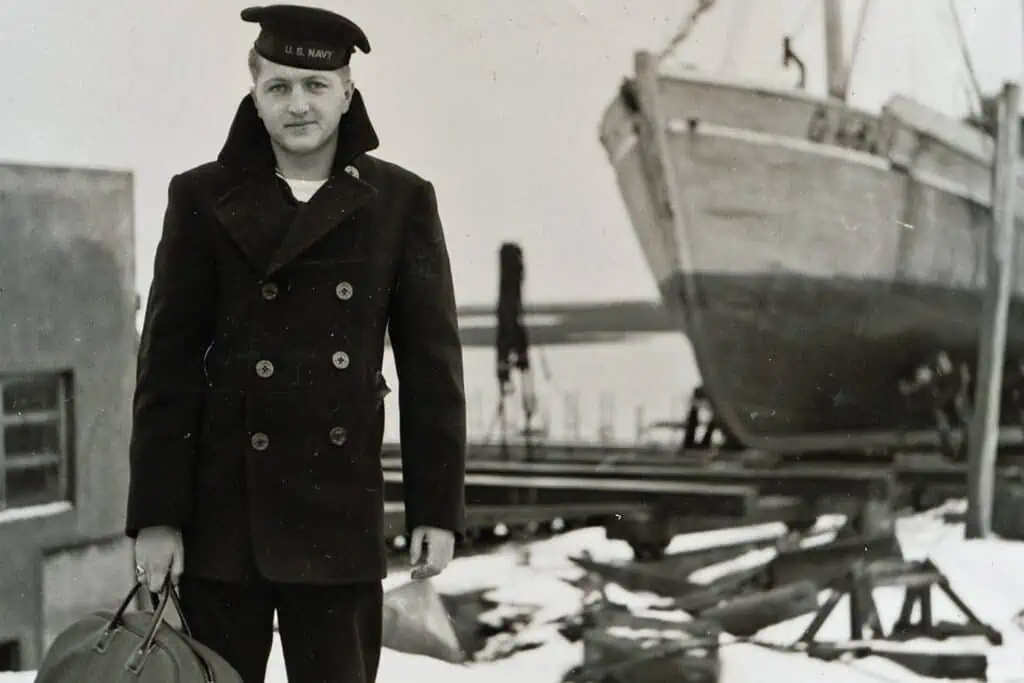
Peacoat Fabric
Today, the US Navy peacoat is made of a midnight blue 24 oz / 750 grams Melton of 80% wool and 20% artificial fibers. Traditionally, it was made of 100% Kersey wool, just like the Melton for the British Warm. As pointed out above, the pilot fabric was an option, and later 100% wool Melton or Kersey was used, often in weights up to 34 oz./1050 grams per yard/meter.
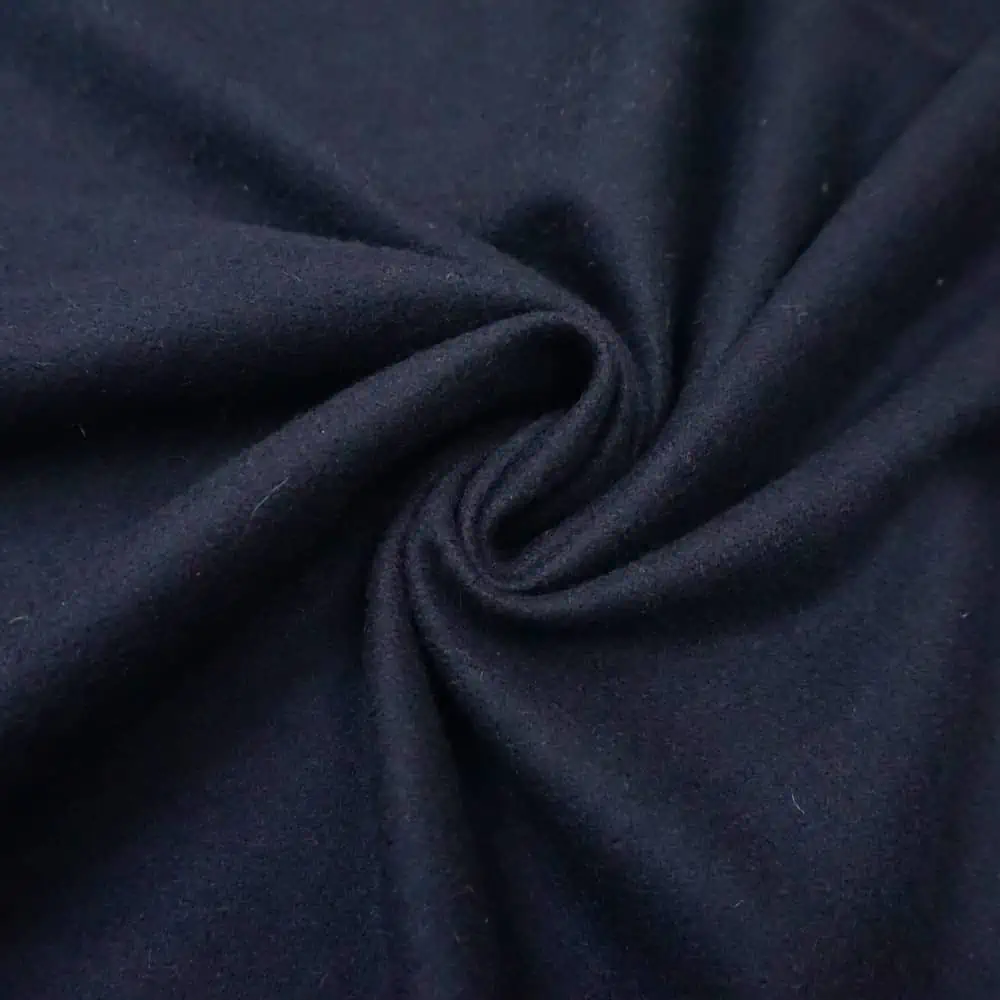
Today, you can still find 100% wool melton fabrics, but usually not heavier than 24 oz, which is a shame because the heavier fabrics provide greater warmth. If you can, get a heavy-weight vintage coat, though good examples in decent shape are few and far between. If you opt for a modern version, skip the nylon and polyester blends and invest a bit more in quality fibers.
Occasionally, you will also find peacoats made in different materials such as canvas, cotton, cotton blend, or nylon, but technically, these are not peacoats.
Learn more about fabrics
Peacoat Buttons
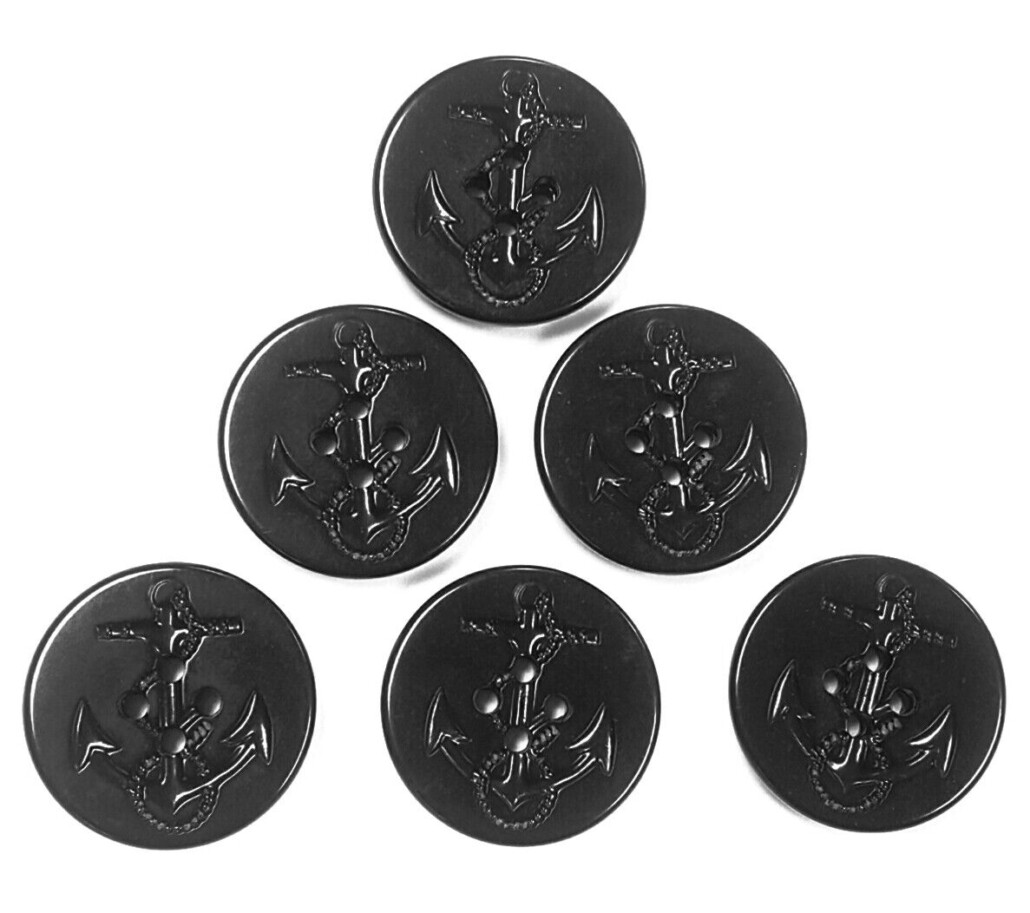
Throughout history, peacoats had a varying number of front buttons, both oversized buttons and conventionally sized. During WWI they often had 10 buttons, later 8, and now mostly 6 with one hidden button under the right collar.
In the US Navy, these buttons are traditionally black. Every once in a while, you will also see gold brass buttons on a midnight blue peacoat. Traditionally, officers, warrant officers or chief petty officers could upgrade their peacoats with these buttons.
Terms to Know: Ligne
A “ligne,” which means “line” in French, is a pre-metric system unit of measurement for very small lengths. Originally one-twelfth of a French inch, the standardized conversion for a ligne is 2.2558291 millimeters. Today, ligne is still used as a unit of measurement in some trades, including watchmaking, ribbon cutting, and button making, although in the button trade, a ligne is defined as one-fortieth of an inch, or 0.635 millimeters. Standard button sizes include 16 ligne for shirts, 24 ligne for jacket cuffs, and 32 ligne for jacket fronts. Coat button sizes can vary greatly, from 36 ligne to over 50 ligne.
US Navy Peacoat Button Designs
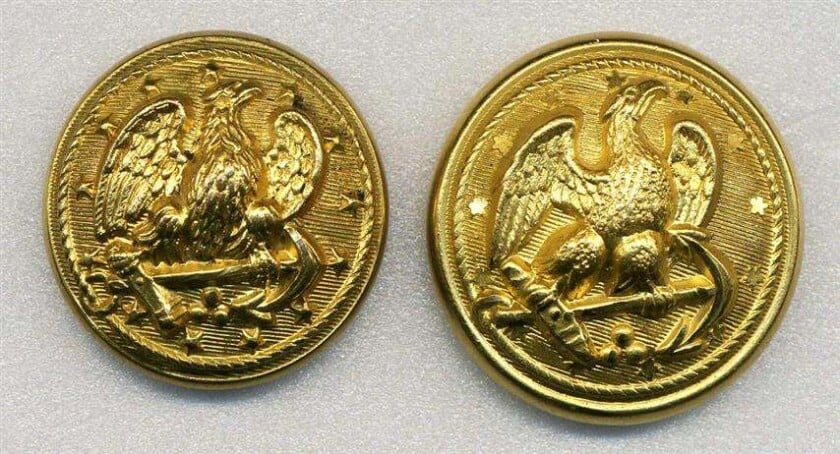
- Starting in the early 20th century, peacoat buttons featured a large fouled anchor in the center with a ring of 13 stars surrounding it, spaced along the edge of the button face. At that time, the coat was also longer and had two additional horizontal pockets.
- By the 1920s, peacoats had the buttons that are used today, but in the 1970s Admiral Elmo Zumwalt had these buttons replaced with 40-ligne (1″) metal buttons that looked identical to the gold ones worn by officers, with the exception that they had pewter color. The “Zumwalt” buttons featured an anchor but only as a perch for a large eagle; they also featured a small stack of cannonballs.
- In 1984, the Zumwalt buttons disappeared again, and “traditional” fouled anchor buttons returned.
- Today, US Navy peacoats feature large (35-ligne) thick black plastic buttons. Imprinted on the front is a “fouled anchor” design, which refers to the traditional image of an anchor wrapped in a rope.
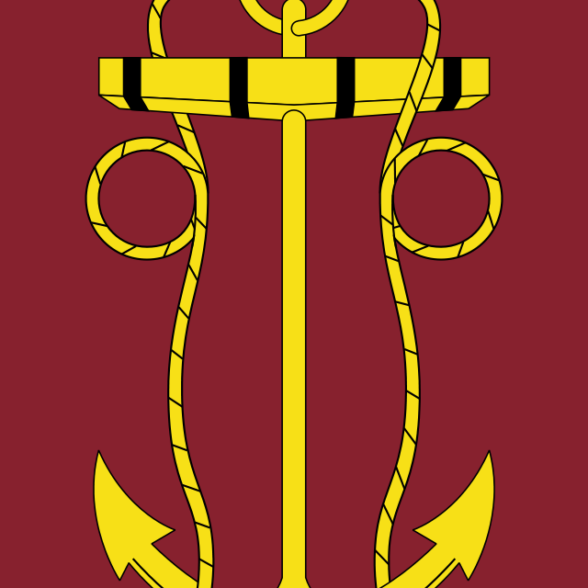
What on earth is a
Fouled Anchor?
In nautical terms, something that is “fouled” is wrapped up or tangled with ropes. According to tradition, this emblem dates back to the personal seal of Lord Howard of Effingham, the Lord High Admiral of England, when the British defeated the Spanish Armada in 1588. Following the victory, the design was then adopted as the official seal of the Lord High Admiral of Great Britain.
While variants of the peacoat are used by many navies, and most use buttons with some variant of the fouled anchor design (with a crown, if the country is a kingdom), it is also true that many of these buttons are of brass, gold plated or not; or of anodized aluminum, also known as “stabrite.” Sometimes the buttons are of black plastic or horn, but with metal shanks rather than four holes for sewing.
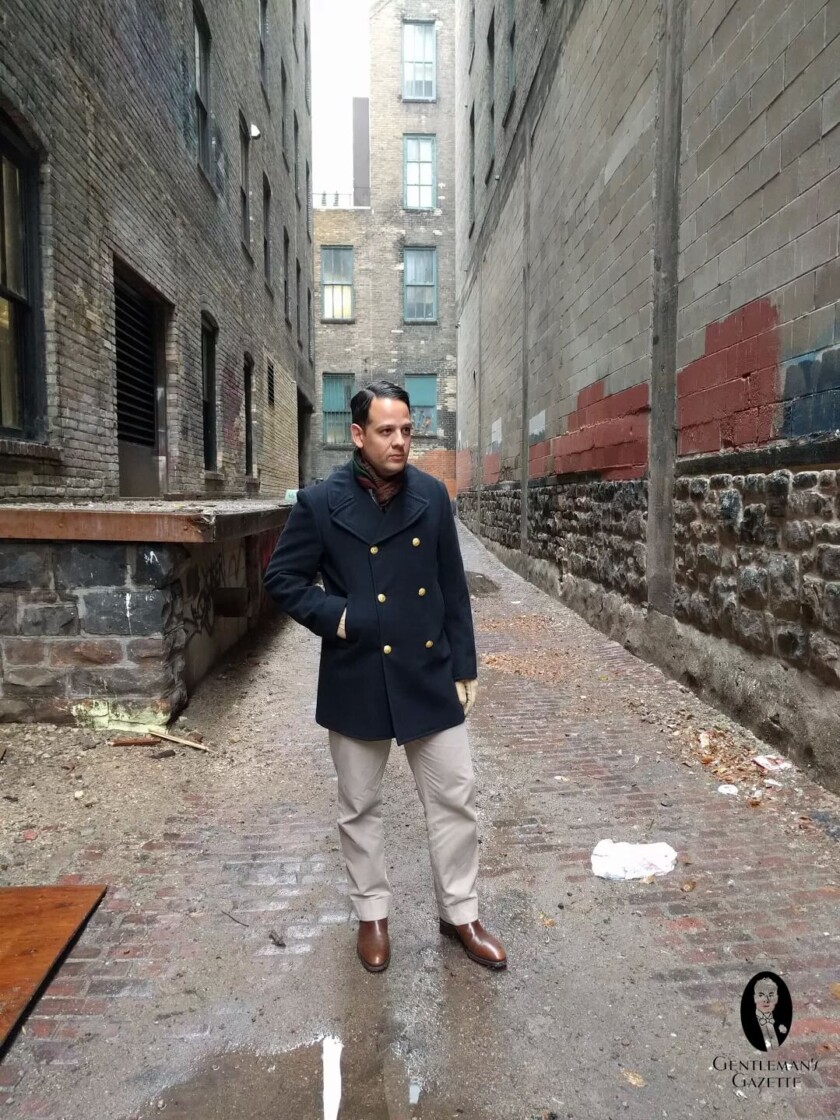
Some will argue that an authentic US Navy peacoat must have black anchor plastic buttons, but you should bear in mind that as a civilian, you can wear whatever you want. For example, a peacoat looks great with gold buttons, pewter buttons, horn buttons, or mother-of-pearl buttons. It’s nice to add a bit of contrast to an otherwise very simple jacket.
Where & How to Buy a Peacoat
If you want to buy a US Navy Peacoat, you can either buy a new one or a vintage one. Unfortunately, the Navy stopped issuing peacoats in May 2019, so new-old stock is the only remaining option if you want an unworn US Navy-issued peacoat.
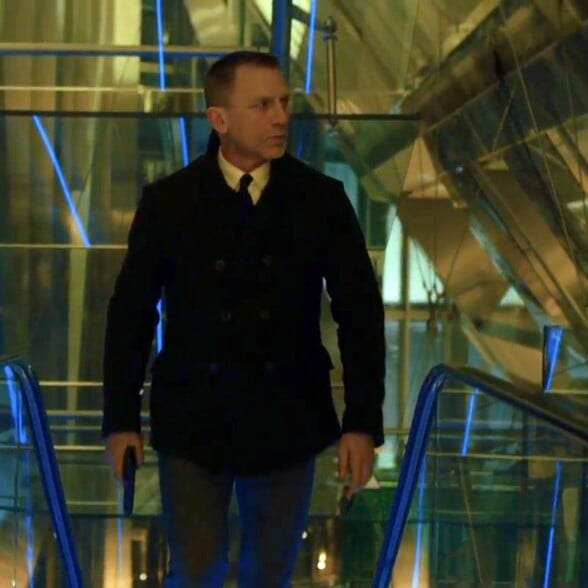
A Military Bond
In the 2012 film Skyfall Daniel Craig’s James Bond wears a peacoat while on a mission in Shanghai, as an homage to the character’s naval background. The coat in question is the “Bond” model by Billy Reid and features a more tailored fit than a traditional peacoat might. Also featured in this design is a streamlined collar with broad lapels, nothing like an oversized collar that you might see in more fashion-forward collections.
Recent peacoats are thinner due to the nylon blended into the fabric, while older versions in good shape are not easy to find. But no matter what you buy, the sizing has to be right to look good.
Buying New Peacoats
There are some other clothing companies that offer peacoats, but most have added their own design elements.
If you are not concerned about strict authenticity, the peacoat from Camplin (now Italian-owned) may be the right choice for you. They come in various colors, but they also cost two and a half times as much as the US-made ones.
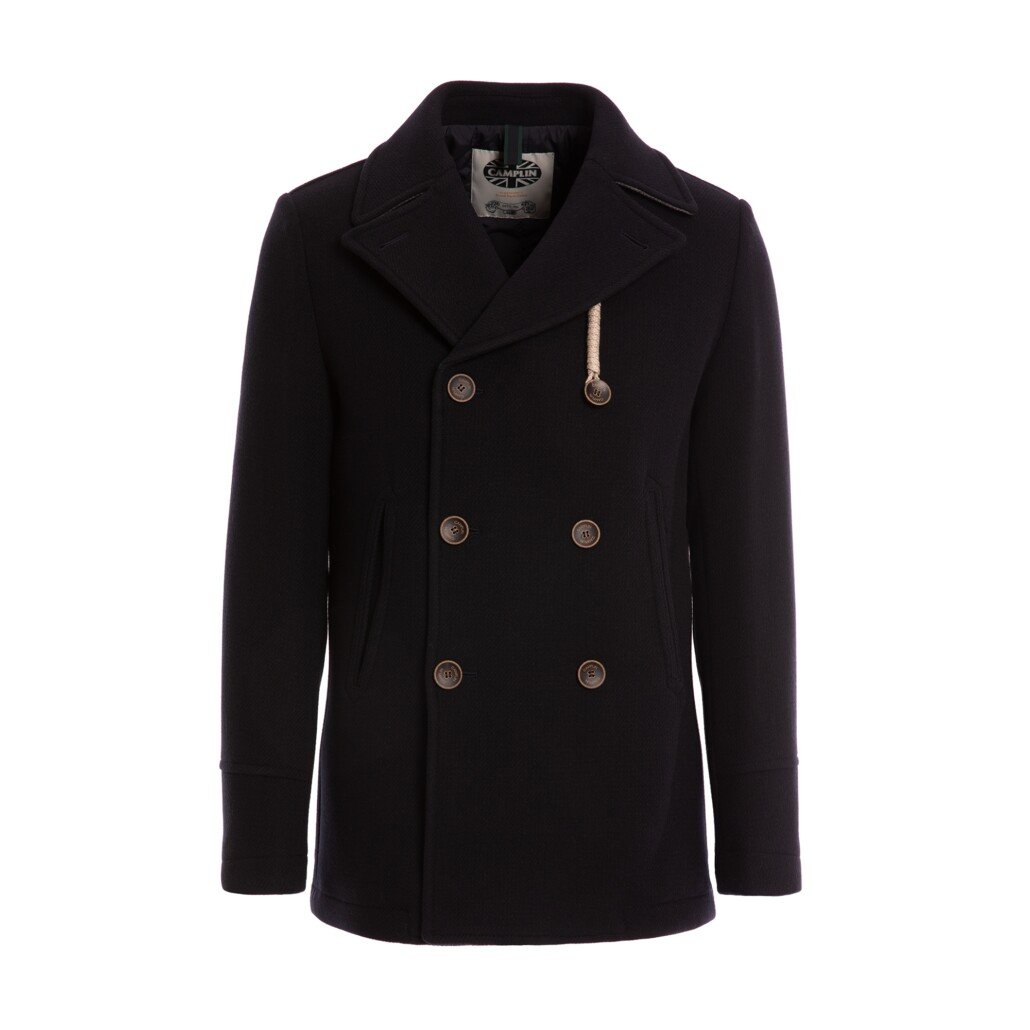
Army-Navy surplus stores are likely to have models in modern wool-synthetic blends; online surplus stores also carry a variety of peacoats. While these are very affordable, and they come in thick 32 oz melton fabric, they are made out of reprocessed wool and nylon fibers, with polyester padding and quilted nylon lining, which can be very uncomfortable for some.
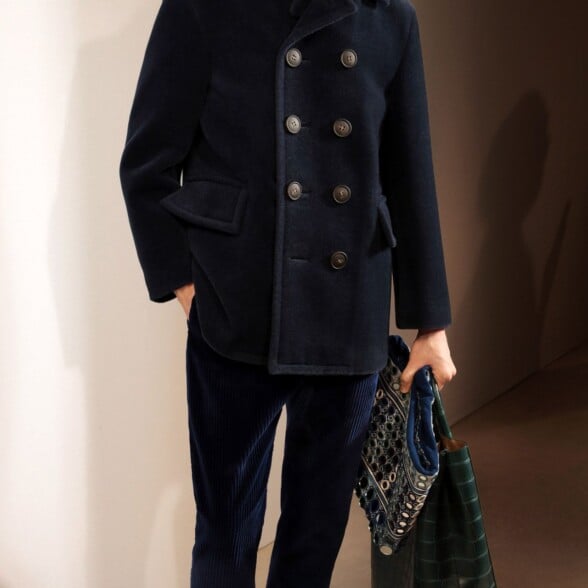
The Peacoat as fashion
Inspiration
Many fashion brands offer their take on the peacoat, which features design elements from the original but with additional elements or ahistorical materials. These “fashion” peacoats may have flap pockets or cashmere blends, and while they may look very similar to a peacoat, technically speaking, they are not. If you like their look, however, they can be a great buy.
Brands Carrying Peacoats and Similar Coats
The following brands offer peacoats and coats inspired by the original peacoat. If you are interested in acquiring a new peacoat, these brands are likely places to start looking. Be aware, however, that many of these “peacoats” are, more precisely, only “inspired” by classic peacoats and are not authentic articles.
| Brand | Cost (2023) |
|---|---|
| Army / Navy Sales | $220.00 |
| L.L. Bean | $299.00 |
| US Wings | $329.00 |
| Schott NYC | $380.00 |
| Gloverall | £499.00 |
| Gieves & Hawkes | $548.00 |
| Brooks Brothers | $598.00 |
| Camplin | € 607.00 |
| Billy Reid | $798.00 |
| Todd Snyder | $898.00 |
| Burberry | $1790.00 |
Buying Vintage Peaoats
Ebay probably offers the largest selection of vintage peacoats, but if you live in the US, consignment stores may also offer one every once in a while. Be sure to employ our tips on how best to shop vintage to identify genuine quality and the hallmarks of a superior quote.
Shop vintage like a pro!
How to Date a Vintage Peacoat
Perhaps you’ve come into possession of a vintage peacoat and you wonder how old it is? Or maybe you want to know when specific details like mid-brown corduroy lined pockets were available? This is our handy guide to help you out!
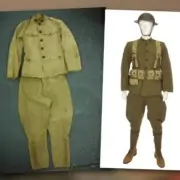
World War I
Peacoats have been around for longer, but it is difficult to find older pictures. During this era peacoats typically had 10 or more buttons, and they were longer. It featured handwarmer pockets as well as flapped pockets. The original buttons featured an anchor with 13 stars around them, and the color was midnight blue. These unique features make it relatively easy to identify a WWI-era peacoat.
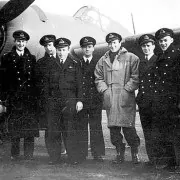
World War II
Compared to the WWI peacoats, the hand warmer pockets were placed a bit lower, and the flap pockets disappeared, but it still maintained the 10-button front. The buttons changed considerably and now featured the fouled anchor you may be familiar with today. At the same time, the stars were removed.
The outer shell was still 100% midnight blue Kersey wool, and the pockets were lined with tan or light brown corduroy: inside the chest pocket you can find a label stating “Manufactured By NAVAL CLOTHING FACTORY.”
The fit of WWII peacoats was very tight compared to the ones that followed.
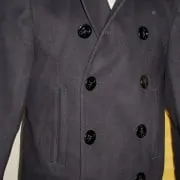
Postwar
Traditionally, the peacoat had 10 buttons, 8 of which were visible. Shortly after World War II the number was reduced to 8 with just 6 visible ones and eventually, just 7 with 6 visible ones.
Because of the reduction in buttons, the lapel got slightly bigger, and you could now see more of the chest or tie. Of course, you could still button it up all the way to keep you warm when needed. This style of the coat was maintained between 1946 and 1979, though the tags were often different, thus making it difficult to differentiate between peacots from these years. Up until the 1970s the 100%, Kersey wool remained unchanged. At some point after that, poly-blended wool was offered.
However, there were some minor differences during this period. For example, in 1968, the corduroy pocket lining was substituted with a soft blue, white, off-white cotton lining.
From 1974 to 1984 the buttons were exchanged once again, so the shape would match the gold bridge coats but the color was pewter. In 1984, the black fouled anchor button was reintroduced but the bridge coats kept their gold buttons.
During that same period, Melton was introduced along with some other changes.
Our friends at the Fedora Lounge have even more info!
Getting the Right Peacoat Size
Traditionally peacoats are worn fitted, but not so tight that the vent gaps or you have wrinkles when buttoning the coat. To find the right size for you, you have to determine how you like the fit of your peacoat and physically measure your chest with a measuring tape.
Modern Peacoat Sizing

For example, Raphael’s chest is 44 inches, and he wears a 42L peacoat, which measures 45 inches in the chest. As he is also 6 ft tall with long arms, he opted for the long version rather than the regular model. This gives enough space to wear a thick sweater or even a jacket underneath it. In case you want to wear less, you should size down by more than two inches. If you like it roomier, size up.
Vintage Peacoat Sizing
Older peacoats were generally cut a little trimmer. Coats from around World War II were the most fitted ones.
The models from the 1950s and 1960s were already a little bigger, and the 1970s version is once again bigger but a bit slimmer than the 1980s versions. The current model is cut the widest. With a WWII coat, a 44L would probably be as wide as the 1980s 42L.
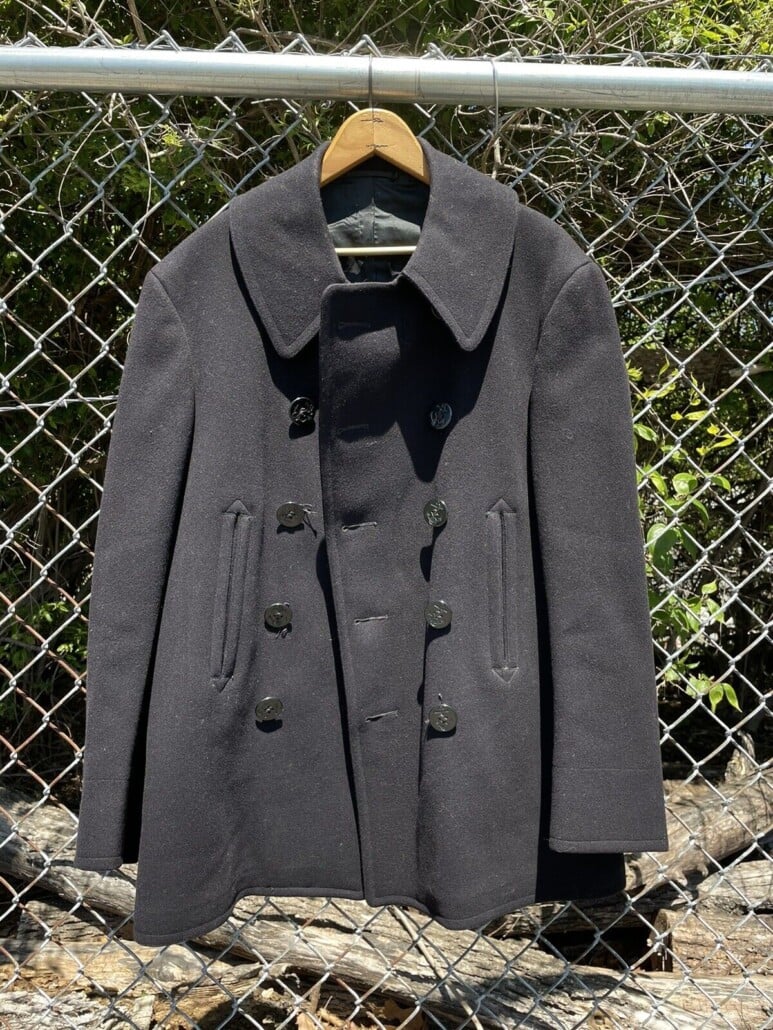
Sometimes, older coats do not have size measurements and in general, we suggest basing your purchases on measurements instead of sizes. Back length, sleeve length, shoulder width, chest width, and, potentially, waist, should be enough to determine whether it will fit or not. Of course, if you have sloping shoulders or a round back it may not fit you, but an alterations tailor should be able to help you if these primary measurements are correct.
Learn the guidelines to perfect fit!
Conclusion
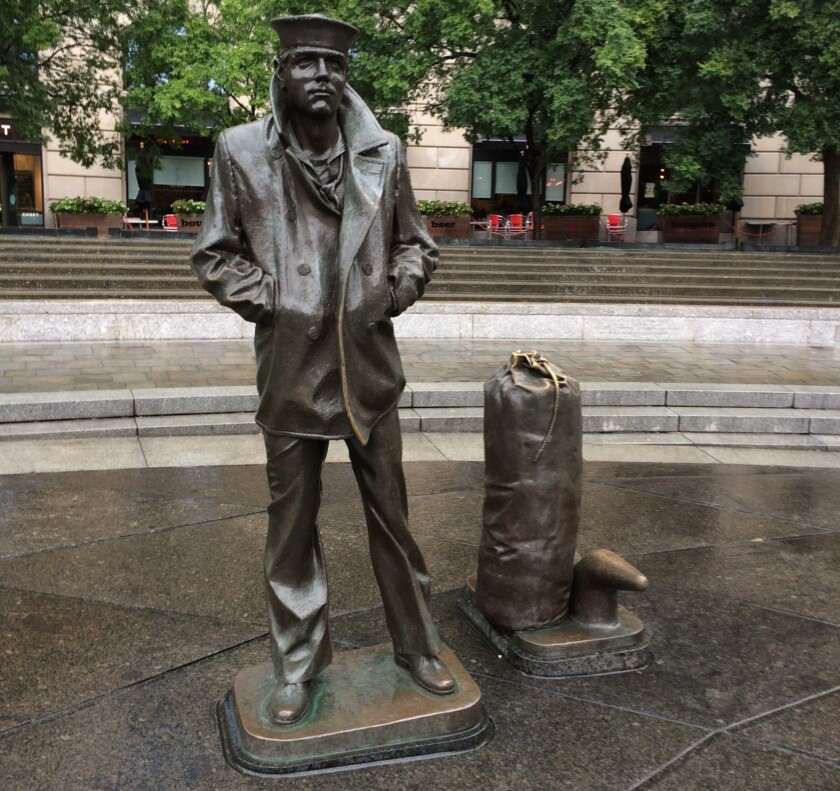
Now that you know more about the history of the peacoat and how to style it, we hope that you will consider making this unique cold-weather coat a part of your menswear ensemble. With a rakish charm born on the high seas and a utilitarian military pedigree, the peacoat represents the exceptional union of form and function.
Do you own a peacoat? Let us know in the comments how you like to style yours!
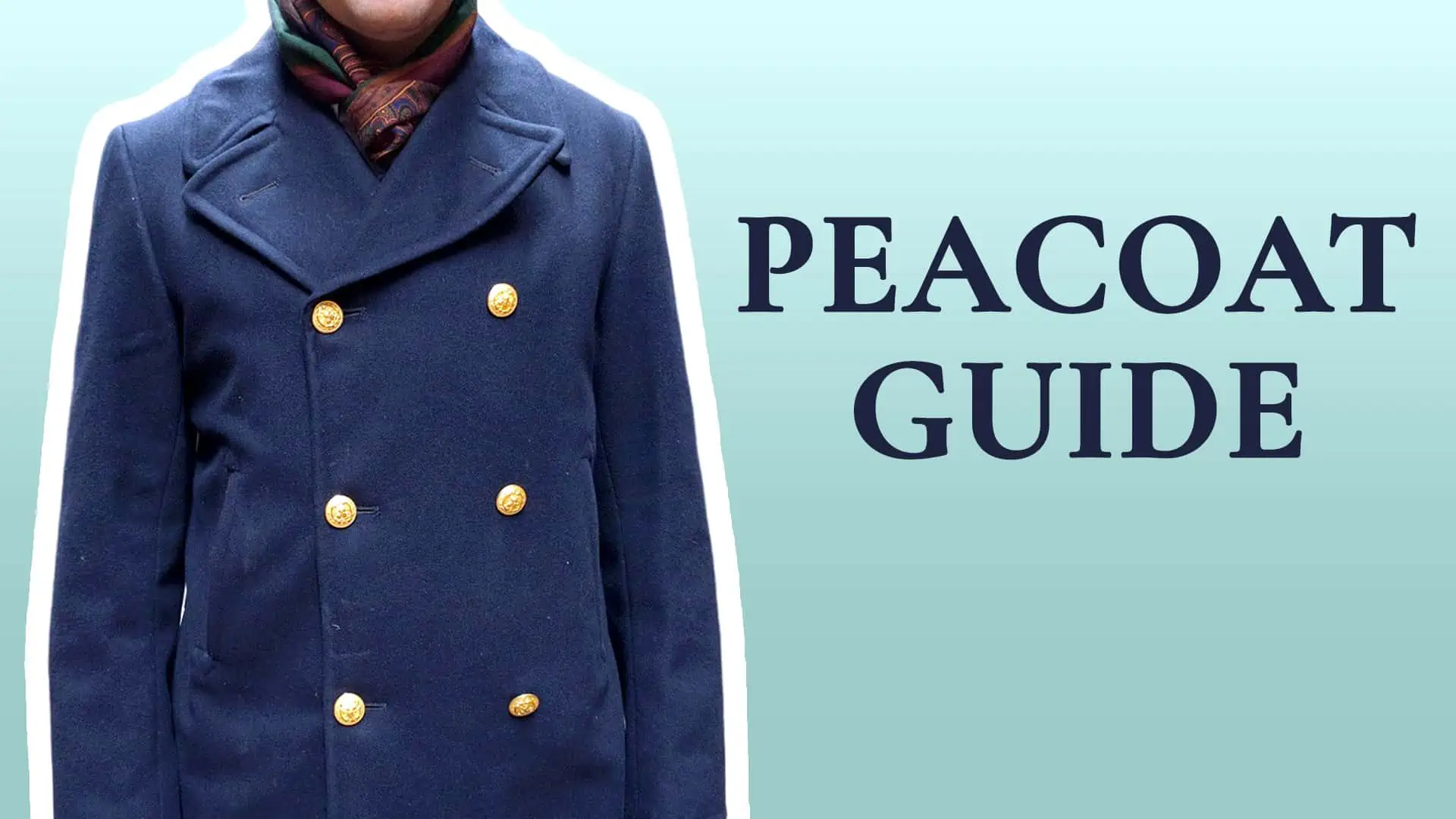
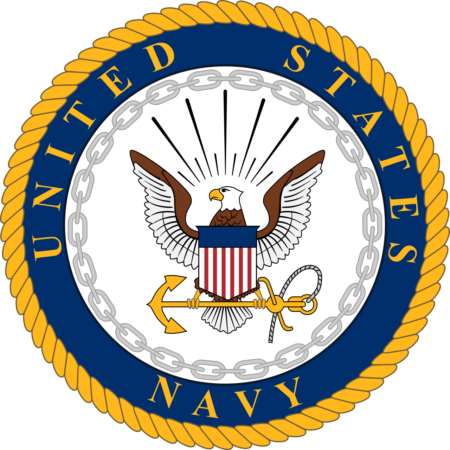
As for the possible Dutch origin: The Dutch historical Dictionary says to “pijjekker” that the first occurance of the word in dutch Texts dates back to 1843, whilst the word “peajacket” occurs as early as 1725. (http://gtb.inl.nl/iWDB/search?actie=article&wdb=WNT&id=M053580&article=pijjakker)
I own a MacGregor Peacoat: I use it just for walking the dog in bad weather; I wouldn’t buy it again, for it has not enough pockets for the usual stuff (cellphone, personal papers etc.).
Thank you Jean! It is interesting to see the different dates in different diictionaries but I trust the Dutch version more when it comes to the Dutch language!
Interesting article. I tend to prefer a longer overcoat, but the peacoat is terribly fashionable these days – or perhaps as you point out, peacoat inspired coats, anyway.
On the question of the origin of the name ‘peacoat’, I see that wikipedia cites the US Navy Department Library ‘Origin of Navy Terminology’ page. This ought to be a pretty reliable source but sadly it then gives no further references. It says:
“The heavy topcoat worn in cold, miserable weather by seafaring men was once tailored from pilot cloth — a heavy, coarse, stout kind of twilled blue cloth with the nap on one side. The cloth was sometimes called P-cloth for the initial letter of the word and the garment made from it was called a p-jacket — later a pea coat. The term has been used since 1723 to denote coats made from that cloth.” (link: http://www.history.navy.mil/library/online/origin.htm#pea)
Make of that what you will. I normally have a deep suspicion of any origin for a word that involves convenient abbreviations or acronyms – they are normally wrong – but it might be right.
Finally, are there any differences between a peacoat and a reefer jacket (which is what they were called in my family) other than the name?
Thanks for the information Hal. I also received some other sources and I shall update this article shortly.
As a retired Commander in the United States Navy, I would like to add my personal insight and experiences. Pea coats were worn by enlisted sailors and had black plastic buttons. The coat was very utilitarian and could be worn with both working and dress uniforms. If officers wanted to wear the Pea coat, they had to buy the enlisted version and have it tailored. The tailor would remove the black plastic buttons and replace them with gold colored Officer buttons with an eagle on them. Additionally the tailor would add two small strips of material on each shoulder so the office could attach hard shoulder boards showing their rank (by number of stripes) and if they were unrestricted line officer (a star) or a staff officer (different emblems). When configured for officers the Pea Coat was referred to as a “Reefer”. Made of similar material but longer in length (to the calf) and configured the same way (gold officer buttons, and strips of cloth sewn on the shoulders to attached hard shoulder boards) that coat was called a Bridge Coat. It was normally only worn by officers with Service Dress Blue (SDB) uniform (the black double breasted coat, black pants, black tie with white shirt uniform). It could also be worn for black tie (dinner dress uniform) functions. Up until only a couple of years ago, the US Navy also authorized officers to wear a Boat Cloak as outer wear for white tie functions. You often see photographs of FDR during WWII when onboard Navy ships wearing a boat cloak. I hope find this information useful and not too pretentious. Thank you for your great article.
I grew up in England and a pea coat was called a reefer jacket.
I actually just came into acquisition of a vintage pea coat in remarkable condition that fit me like a glove. All that was wrong with it is the lining coming off of one of the sleeves, which I’m going to have repaired. After looking at the link on dating, I tried to search again for tags, and looked into the inner pocket, and was delighted to find that it had a date of production of 1936, and an issuing date of 1942.
John, I am glad to see that this article and its links were useful to you – that’s what we want to provide, useful, definitive insights that helps our readers.
Thank you for the info. Great read. Could you please tell me from which year the double row of stitching above the cuff started and ended? Thank you
Ryan, are you referring to the double stitching in the Camplin picture? I am not sure to what extent that is just their design.
No, not the camplin pic. I am refering to the original US Navy pea coat. Some of the pea coats had them…
I see what you mean now. During WWI they had just one row but in 1949 they already had the double stitching. So it must have started sometime in between. It certainly ended with the 1967 peacoats. Did you acquire a coat with double stitching or why are you asking? Maybe the label could help to date it more precisely.
I would like to get one with the double row of stitching, but it’s proving to be a difficult task.
Sven,
Thanks for the article! I linked over from AoM. My Pea Coat was issued to me in Feb of 1992. Any idea when they changed from wool to a blend? I’ll be checking out the details on the two that I own (one for me, issued, one for my wife that I got later)!
K
Nice article and history lesson although I don’t think the pea coat is for me. My son is in the Navy and I just don’t want to go around looking like one of his pals.
I think that the closest to the real deal that you can buy today is Buzz Rickson’s Pea Coat, 36 oz Melton Wool and mil spec urea buttons, it’s very expensive but I think it’s worth: http://www.buzzricksons.com/us-navy-pea-coat-p-45.html
At that price, I think Sterlingwear is preferable.
Sterlingwear is surely cheaper but 24oz and 80/20 blend is not very close to the original, Rickson’s europe is very expensive (I got mine months ago from a UK online shop during a sale) but if you buy directly from japan (rakuten) for example here: http://item.rakuten.co.jp/hinoya/br11554 it’s about $430 so a much decent price.
I’m disappointed the J Hilburn updated 100% wool Peacoat was not mentioned in your “places to buy”.
Lori Johnson
J Hilburn Personal stylist
My experience with J Hilburn is anything but great. Therefore we do not recommend J. Hilburn at this time.
I got mine the old fashion way- it was issued to me at Naval Training Center Orlando (Boot Camp) in 1982. It was heavy and very clean and stiff- smelled a lot like a Mothball. While it was unreasonably cold in Orlando, it was ridiculously numbing in New London Conn. during the follow on training Basic Enlisted Submarine School. The barracks was cold, I was cold and my Peacoat offered little hope. It turns out that the Peacoat is a great barrier layer but not a great warming layer. We were educated there in “Rotten Groton” that the wool sweater that came issued with that Peacoat would provided the warming layer to which all that fine barrier wool of the Peacoat did provide. The Peacoat trapped the warm body air and held it well against blowing rain, snow and as I found out sea spray. Mine was a Zumwalt model with the smaller buttons of which I prefer as they are easier to engage. We didn’t wear them normally though as the Deck Jacket was the norm on board my Boat. Peacoats were kept for formal occasions- read: inspections. Still, I wear it today, with a comfortable cashmere “submariner” sweater. I am sure with a good coating of whale oil I would be well suited to climb the mast of any tall ship and keep “Lookout.” Carney of USS Ray SSN 653 fame.
Sven,
Great article. A small technicality — Sailors wear peacoats; officers and Chief Petty Officers wear a Reefer. The only difference is the gold buttons (for both the officers and Chiefs) and fabric loops for attaching the officer’s shoulder boards. But you can’t walk into a Navy Uniform Shop and buy a Reefer; you buy a peacoat and the gold buttons, take them to the tailor and ask that it be converted to a Reefer.
Regards,
Mark, Navy Retired
Mark, of course I know the naming declaration but 1. people do not know the reefer coat but the peacoat and 2. As you say it is exactly the same garment except for the buttons. I understand that the military has certain naming conventions but to me they are the same garment. What do you think?
Former USN (79-83) – when I was in, the officer’s reefer coat was longer than the pea coat. The enlisted pea coat hit just at the crotch while the reefer coat ended just above the knee. The reefer coat also had a 2-button strap across the mid-back, and shoulder boards.
I recently found this coat on Amazon – Seibertron Men’s Woolen Coat US Navy Type 80% Wool USN Pea Coat – at an excellent price point. I still have my original issue pea coat (Great Lakes in December 79) with silver buttons that sadly doesn’t fit any longer, but I compared it to the Seiberton coat at it is a very good and faithful reproduction in all respects.
Great article!
Delighted to see an article so focused on vintage pea coats. But I am dismayed that so many people appear to be paying so much.
Maybe the supply has dwindled drastically in the last eight years, but about that long ago one could be had, in near mint condition, for $70-$125 on eBay if you were patient and knew what you were looking for. I paid $80 for an early Vietnam-era coat, still the very trim cut, with corduroy lining the pockets.
One can’t go wrong, really, if you find a coat that fits and is Melton and not the wool blend! Be patient—if my experience still applies, it will only take a couple of months to find something that you will wear proudly for the rest of your life.
Delighted to see an article so focused on vintage pea coats. But I am dismayed that so many people appear to be paying so much.
Maybe the supply has dwindled drastically in the last eight years, but about that long ago one could be had, in near mint condition, for $70-$125 on eBay if you were patient and knew what you were looking for. I paid $80 for an early Vietnam-era coat, still the very trim cut, with corduroy lining the pockets.
One can’t go wrong, really, if you find a coat that fits and is 100% wool and not the blend! The 80% wool coats are a joke compared to what came before. Be patient—if my experience still applies, it will only take a couple of months to find something that you will wear proudly for the rest of your life.
I own a dark blue Schott pea coat. Had it a good few years now and it is still as warm and comfortable as ever. I wear it in snow,rain,sleet and I’m never cold. Excellent coat would recommend.
I HAVE A QUESTION… WHAT’S THE DIFFERENCE FROM A TOP-COAT TO AN OVER-COAT….? THANK YOU…!!!!
There you go, the difference is explained here in our topcoat, overcoat, greatcoat guide.
I , and rest of troopmates, were , in 1972, issued with “pea coats” either as part of our initial kit issue or issue of our dress level issue uniform. I had it for a number of years until i gained weight and it didnt fit; cant remember how I eventually disposed of it. But…i wish I still had one of the same style cut and weght…loved it. They are not normally worn now in winter as they have, to the best of my knowledge, been replaced by a much warmer but significantly less dressy “storm parka”.
I am a big fan of original military clothing And bought my pea coat at a military surplus store. I truly think mine is original ( not sure what era vintage or modern) because inside it has a pocket with someone last name and last four digits of ss number. Also, the tag reads DSCP any info on that?
Thank you.
There is an excellent series of forum entries from 2009 on thefedoralounge.com. I was seeing a button back onto a pea coat my son has been wearing to high school. I also stitched the lining in the armhole where it was coming undone. According to the label dating info on the forum, it’s a 1966 coat. Kersey wool. It’s in perfect shape and it’s built like a tank. It’s interlined with what appears to be wool felt. And the armhole seams are reinforced with twill tape in the seam. Nice coat. Now I’m thinking I shouldn’t be letting my 17 year old year wear it. My husband got this coat in the 1980s from his uncle (a navy man) who had a ferocious garage sale habit. I hung unworn in our hall closet for 20 some years since my husband thought it too warm for use here in Texas.
Autocorrect slaughtered that! The pea coat dating info can be found on the forum at thefedoralounge.com.
What are your thoughts on the Classic Melton Peacoat offered from Schott NYC? I believe they claim to have been issued to the U.S. Navy at one point or perhaps they are replicas. Either way they seem like great coats and are very traditional looking
Last time I checked, it was not 100% wool and the price seemed high, but I never owned one.
I have to disagree about Burberry not carrying an authentic peacoat. I purchased mine there, and it is 80% wool. Very heavy weight. They have been in the business of making coats since WWI..
Do you have a link Sean? They have somethign listed on their website with cashmere, but to me that’s just fashion item, not a peacoat.
Around 1994, I bought a Peacoat at the Collingswood Flea Market in New Jersey, off route 33. It was at an Army-Navy kiosk. It cost me $69 and I’ve used it in the winter months since then. It does have the sailors name in the name tag in the inside breast pocket. I don’t think he ever wore it since it was in perfect brand-new condition.
I worn it hundreds of times in the winter especially when I was snow blowing my driveway. But I wear it less so now due to earth warming and no snow storms in New Jersey.
What is absolutely amazing to me is that it shows no wear at all. The armpits and interior lining are just like the day I bought it. It is heavy and therefore very warm.
The Peacoat look-a-likes that are sold in Lord and Taylor, Macy’s or Nordstrom have no comparison.
What is different than the one Raphael describes is that my coat has 6 button plus the one under the collar, not 8, like the photo of the sailor. I don’t know why it not 8 buttons
.
Sal Runfola
Just for the record, the seaman in the lead news photo for this article is a petty officer in the Royal Navy in the early 1900s. His ship, HMS Crescent, was stationed at Halifax at the time. I’m not aware of the use of peacoats in the Royal Navy, but this is a uniform jacket.
Fabulous. It’s great that the Internet can still be used for interesting, knowledgeable stuff. I have just purchased a coat from a retro store near King’s Cross in London for a discounted 25 pounds! Did great and it’s at the dry cleaners now. 8 buttons. Stencilled name inside, tags removed but corduroy pockets. If now date it from Korea to Vietnam era thanks to this great article. I’m really pleased with my find it’s in great condition.